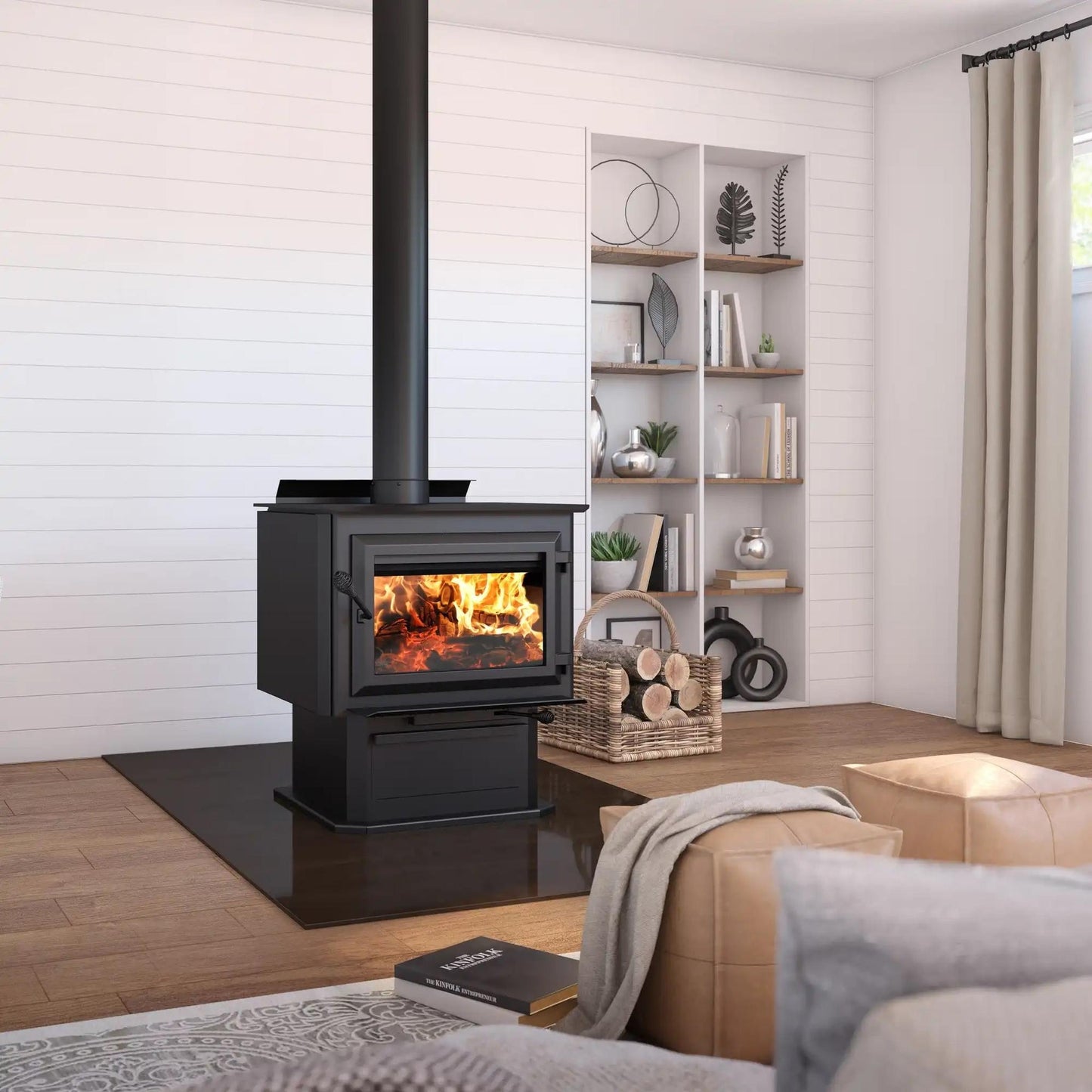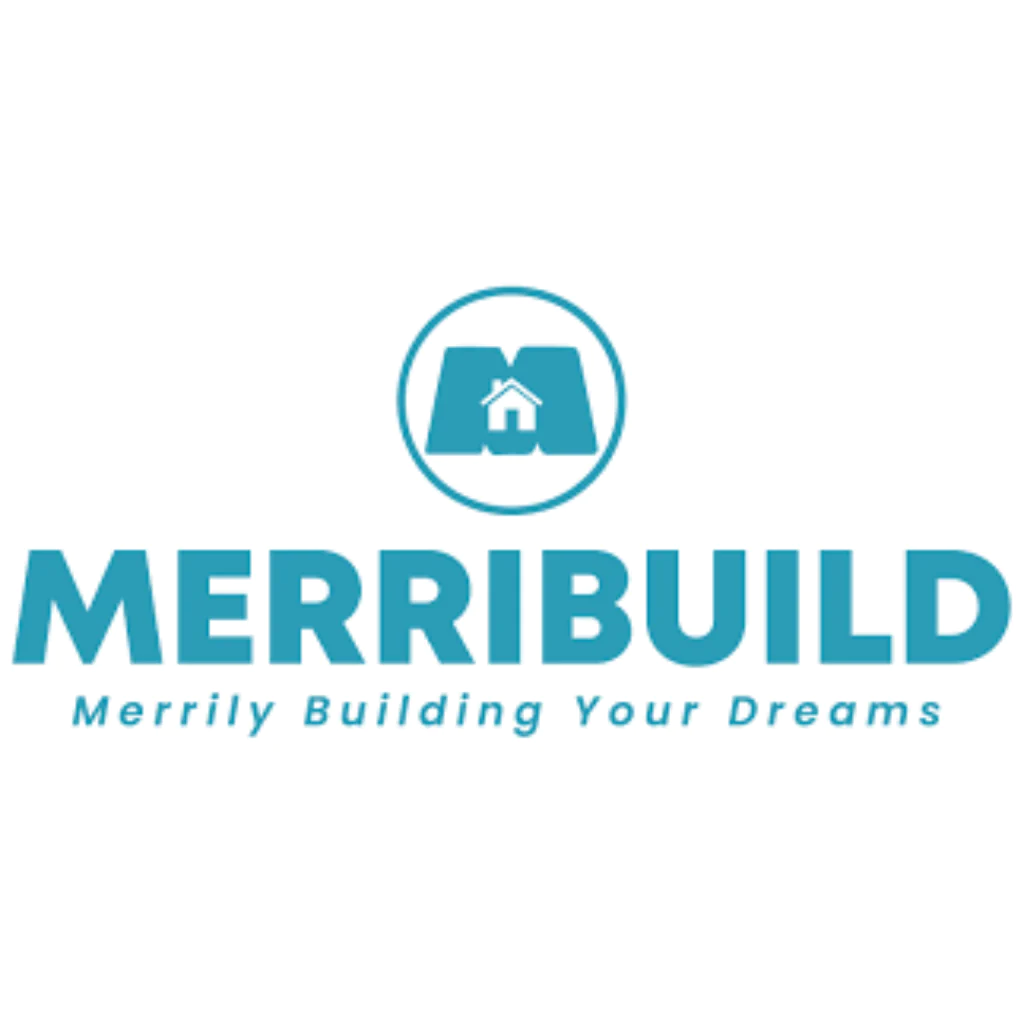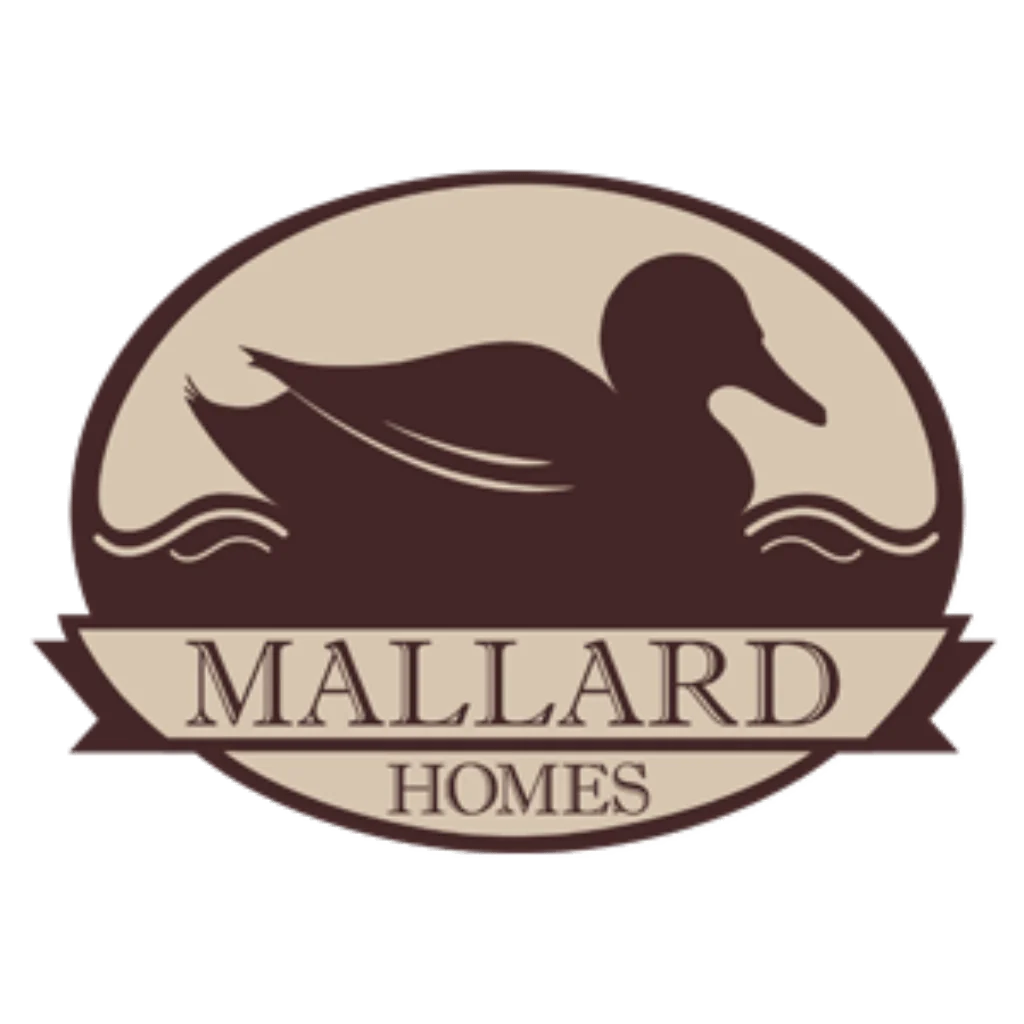SKU:VB00020
Ventis HES350 29" Black Wood Burning Extra Large Stove With Pedestal, EPA2020 Certified
Ventis HES350 29" Black Wood Burning Extra Large Stove With Pedestal, EPA2020 Certified
Options & Accessories
Couldn't load pickup availability
- Free Shipping on Orders Over $400
- Same-Day Order Processing
- Easy Monthly Installments Starting at 0% APR*
• Text or call 888-992-1556
• Email support@usfireplacestore.com
• Start a live chat
Our team is available to serve you 8:00 AM - 11:59 PM ET, 7 days a week.
Ventis HES350 Wood Stove on pedestal is designed to accommodate a large spaces. It has a 3.5 ft³ firebox, which is one of the largest fireboxes for a freestanding wood stove. This unit features non-catalytic combustion technology and will heat up to 2,700 sq. ft. It can handle up to a 22-Inch log and produces up to 110,000 BTUs. It will keep you warm in the winter months with a maximum burn time of 10 hours.
Please Note: This stove is eligible for tax credits.
What's Included
- HES350 wood stove
- Cast iron door
- Top heat deflector and side panels
Not Included (Sold Separately)
- Rigid firescreen
- 5"Ø fresh air intake kit
- 130 CFM Blower With Thermodisc
Features
-
Extra-large wood stove on pedestal
-
EPA certified at only 1.6 g/h
-
Solidity and manufacturing quality
-
C-Cast heat shield added to the firestop
-
Non-catalytic combustion technology
-
Installation authorized on the Island of Montreal
-
Cast iron door
- Top heat deflector and side panels
Specifications
| Appliance performance |
| Fuel type | Dry cordwood (16" recommended) |
| Recommended heating area | 1,000 - 2,700 ft² |
| Overall firebox volume | 3.5 ft³ |
| EPA loading volume | 2.88 ft³ |
| Maximum burn time | 10 Hours |
| Maximum heat output-dry cordwood | 110,000 BTU/h |
| Minimum overall heat output rate | 17,200 BTU/h (5.0 kW |
| Maximum overall heat output rate | 57,800 BTU/h (16.9 kW) |
| Average efficiency-dry cordwood (HHV) | 71 % |
| Average efficiency-dry cordwood (LHV) | 76 % |
| Optimum efficiency | 77 % |
| Optimum heat transfer efficiency | 75 % |
| Average particulate emission rate | 1.6 g/h |
| Average CO | 73 g/h |
| General Features |
| Model | HES350 |
| Ignition Type | Manual |
| Alcove installation approved | Yes |
| Mobile home approved | Yes, with fresh air intake |
| Premium quality blower included (CFM) | Optional |
| Certified according to applicable standards | CAN/USA accredited laboratory |
| Combustion technology | Non-catalytic |
| Stainless-steel secondary-air system | Yes |
| Flue outlet diameter | 6" |
| Recommended chimney diameter | 6" |
| Type of chimney | CAN/ULC S629, UL 103 HT (2100 °F) |
| Minimum chimney height | 12" |
| Door type | Single, glass with cast iron frame |
| Glass type | Ceramic glass |
| Glass surface - W x H | 18 3/8" x 11 1/2" |
| Steel thickness-body | 3/16" |
| Steel thickness-top | 5/16" |
| Maximum log length | 22" |
| Log positioning | Loading over width and over depth |
| Firebox lined with refractory bricks | Yes |
| Baffle type | High quality vermiculite |
| High-efficiency certified appliance | Yes, EPA 2020 certified |
| Canadian Standard (emissions) | CSA B415.1-10 |
| USA Standard (emissions) | EPA |
| Canadian Standard (safety) | ULC S627 |
| USA Standard (safety) | UL 1482, UL 737 |
Dimensions
| Overall Dimensions |
| Overall dimension (Width) | 29" |
| Overall dimension (Height) | 35" |
| Overall dimension (Depth) | 31" |
| Firebox Size |
| Firebox size (Width) | 23" |
| Firebox size (Height) | 13" |
| Firebox size (Depth) | 20" |
| Door Opening Size |
| Door opening size (Width) | 18" |
| Door opening size (Height) | 11" |


Warranty

| Description | Parts | Labour |
| Combustion chamber (welds only), castings and convector air-mate | Lifetime** | 4 years |
| Plating* (defective manufacture) - subject to limitations above Ceramic glass (thermal breakage only*) |
Lifetime** | N/A |
| Stainless steel firebox components, vermiculite, C-Cast or equivalent baffle* and secondary air tubes*, glass retainers and handle assembly |
5 years** | 3 years |
| Surrounds and heat shields, ash drawer, steel legs, pedestal and trim (aluminum extrusions) |
5 years | N/A |
| Carbon steel firebox components | 3 years | 2 years |
| Blowers, heat sensors, switches, rheostat, wiring and electronics | 2 years | 1 year |
| Paint (peeling*), gaskets, insulations, refractory bricks (fireplace only**) and ceramic fibre blankets |
1 year | N/A |
| All parts replaced under the warranty | 90 days | N/A |
Documents & Files
- Download Product Catalogue
- Download Installation and User’s Manual
- Download Safety & General Information
- Download Fresh Air Kit Installation Instructions
- Download Tax Credit Qualification & Summary
- Download Appliance Dimensions
Frequently Asked Questions
What makes a heater mobile-home approved?Mobile-home approved stoves have gone through specific testing to show that they can source their combustion air entirely from outside the house. This is required because mobile homes (or manufactured homes) are often very airtight. Should there be a lack of combustion air, harmful levels of CO (carbon monoxide) could accumulate in the house. This is why mobile-home approved stoves have an adapter that hooks-up to the unit and connects to a fresh air intake on the outside wall of the house through an insulated pipe. |
Why doesn't my heater produce enough heat?Possible causes and solutions: The moisture content of your wood is too high. Solution: Make sure you use good, seasoned wood. The wood you burn plays an important role in the overall performance of your heater. Your wood should have been properly dried for about one year. Furthermore, it is better to use hardwood, such as oak, maple, beech, or ash. For the same volume, hardwood will produce more heat. Storage is also very important. Wood that has been cut for one, two or even more years, will not necessarily be dry if it has been stored in poor conditions. Under extreme conditions, it may have rotted instead of drying. Smaller pieces of wood will dry faster. The wood should be stored in a place where the grass is not too long, and where the wind will be able to circulate between the logs. A 12-inch gap should be kept between the cords. The wood should be placed in the sunniest area and should be protected from the rain and snow on top, but not on the sides. Use a moisture reader to measure the moisture content of your wood. Ideally, it should be below 25%. The air control mechanism is not open enough. Solution: Adjust the air control mechanism in order to keep the flue temperature within the comfort zone (between 250 °F and 475 °F) on your chimney thermometer. The air control mechanism must always be closed gradually. You need to obtain a good bed of red embers and the logs must be completely lit up before you close the air control completely. This can easily take up to one hour. The logs that you are using are too big. Solution: Use smaller pieces of wood and place them to allow proper air circulation between the logs. The same weight of wood cut in many small pieces will produce more heat than fewer, larger logs. Only add big logs when you have a good bed of red embers. Logs with a diameter exceeding 6 inches should always be split. Avoid stacking logs to the top of the firebox. The chimney draft is too weak. Solution #1: In many cases, a weak draft is simply due to insufficient heat in the exhaust system. Build a small, intense fire, and leave the door ajar (never leave the heater unattended). Before inserting larger logs, use dry kindling to obtain a good bed of red embers. Gradually increase the size of the logs. Close the unit’s door when you reach a flue temperature of approximately 475 °F on the chimney thermometer. Leave the air intake fully open for approximately 15 minutes. Then, gradually close the air intake control. Note that there is no danger in letting the temperature inside the flue reach approximately 700 °F during the start-up. This is even favorable in order to properly start your heater. You must, however, avoid maintaining excessive temperatures (above the comfort zone on your thermometer) during a long period of time. Your chimney thermometer should be positioned on the exhaust pipe, approximately 18 inches above the unit. Solution #2: Your heater may not have all the oxygen it needs to allow for a sufficient draft. You first need to ensure that the room where the heater is located is sufficiently large and well ventilated. Open the nearest window by approximately 2 inches. If you notice a significant improvement, it is a sign that the unit needs more oxygen. The room may be too insulated or too small. Without an additional source of oxygen, the draft will remain weak and cause the glass stay dirty. Solution #3: The chimney may be too short. In order to obtain a sufficient draft, your chimney must have a minimum height. Twelve feet (from the heater to the chimney cap outside the house) is a minimum. A height of 15 feet or higher is ideal. Solution #4: Your exhaust system may be too restrictive or may lack a sufficient rise. Ideally, your exhaust system should not have more than one 90° elbow. Furthermore, all horizontal sections should be as short as possible and have a minimum slope of ¼" per foot. Solution #5: Your exhaust system may be oversized. When your chimney is oversized, the volume of air that needs to be warmed-up is larger. It is therefore difficult to reach temperatures that will allow for a sufficient draft. Most advanced combustion systems (those certified to EPA/CSAB415.1-10) have a 6" flue outlet (152 mm). If your exhaust system does not have a 6" diameter, a solution is to insert a stainless liner with a 6" diameter inside the exhaust system. If you have verified all the points mentioned above and your heater works fine, but still does not produce enough heat, you may be asking for more than what your appliance can realistically give you. Stoves, fireplaces, and inserts are used for "zone heating”. It is normal that the heat is distributed unevenly inside your home. It will always be colder in the rooms that are distant from the heater. Furthermore, since heat rises, a heater located at the ground-floor level will not heat your basement. Solution #6: It is possible to increase heat circulation between the floors by installing floor traps. The location of your heater is also important. Try to install it in a central location. If you want to heat both your basement and the ground floor, install your heater in the basement. The heat will rise to the upper floors. Verify that the area you try to heat respects your appliance’s heating capacity. Your appliance’s heating capacity can be found on the printed literature, in the owner’s manual, or in the technical data section on our web site. Keep in mind that your appliance's heating capacity assumes optimum conditions. It may be too low in situations where a house is poorly insulated, or highly exposed to wind. If you already have an appliance with a high heating capacity that works normally but does not heat enough, you probably need a central heating system, such as a warm air wood furnace. |
Does my heater qualify under the LEED program?The Leadership in Energy and Environmental Design (LEED) Green Building Rating System™ encourages and accelerates global adoption of sustainable green building and development practices through the creation and implementation of universally understood and accepted tools and performance criteria. LEED is a third-party certification program and an internationally accepted benchmark for the design, construction and operation of high performance green buildings. It provides building owners and operators the tools they need to have an immediate and measurable impact on their buildings’ performance. The Canadian Green Building Council (CGBC) certifies LEED projects. The Certification is based on the total point score achieved, following an independent review and an audit of selected Credits. With four possible levels of certification (certified, silver, gold and platinum), LEED® is flexible enough to accommodate a wide range of green building strategies that best fit the constraints and goals of particular projects. The Canadian rating systems are an adaptation of the US Green Building Council's (USGBC) LEED Green Building Rating System, tailored specifically for Canadian climates, construction practices and regulations. The rating systems are adapted to the Canadian market through an inclusive process that engages stakeholders and experts representing the various sectors of the Canadian industry. |
Why is the BTU according to EPA test data smaller than the one advertised?You will notice a difference between the BTU output as per the EPA’s test data and what is advertised on our web site and/or product literature. The maximum BTU output we advertise is what will be obtained with a full load of seasoned cordwood inserted inside the firebox. The EPA output, on the other hand, is what has been obtained during emissions testing. The EPA test procedure requires that a special type of wood is used and positioned inside the firebox in a manner that does not represent the way the firebox volume would normally be utilized using seasoned cordwood. The EPA test load is typically much smaller. Hence, the BTU as per the EPA’s test data is reduced. The BTU output that should be considered by a normal user is the one we advertise for seasoned cordwood. |
Do I need an EPA certified or CSAB415.1-10 certified heater?You first have to identify what your needs are. If you are looking for ambiance, a temporary heat source in a cottage or a camp, or a simple back-up heat source in case of power failure, you do not necessarily need to invest more money in order to buy an EPA or CSAB415.1-10 certified wood heater. However, if your goal is to heat on a regular basis, the extra dollars will prove to be a good investment. Furthermore, it must be noted that certified heaters release up to 90% less particles into the atmosphere, which makes wood a renewable and clean source of heat. As a result, if the style and size of the heater you are looking for is available in a certified version, it is highly recommended that you invest in this advanced combustion technology. You will help the environment and reduce your wood consumption by up to 30%. NOTE: If you live in the United Sates, British Columbia, Ontario, Quebec, Nova Scotia, New Brunswick or Newfoundland, EPA certified wood heaters are mandatory. Exceptions apply for certain categories of products, such as decorative fireplaces. Certain municipalities may also have by-laws that require the installation of an EPA or CSAB415.1-10 wood heater, even though the province does not have an official regulation on wood heating. It must also be noted that in Canada, the CSAB415.1-10 Standard is equivalent to the EPA Standard. A wood heater that meets this Standard will generally comply with the regulation in place. |
Do I need to install a fresh air intake on my wood heater?A fresh air intake is not mandatory for your wood heater, unless the unit is installed in a mobile home or if the local building code or the manufacturer requires it. If the heater is installed in an open room, in a house that is more or less air-tight, combustion air will normally be easily replaced. In this case, the installation of a fresh air intake is not required. It must, however, be noted that a fresh air intake, even if it is not mandatory, will always provide the advantage of better balancing the house with regards to combustion air. If the house has a powerful mechanical exhaust system that may be used while the heater is burning (ex: range hood), a fresh-air intake will be required. |
Do I need a floor protection under and around my heater?Yes, floor protection is required for any wood appliance unless the unit already sits on a non-combustible surface. You have many choices, such as stone, brick, cement board, or tile. You need to consult your owner's manual in order to know the dimensions of the floor protection specific to your model. In Canada, the floor protection must extend in front of the unit by at least 18 inches and by at least 8 inches on each side. In the USA, the floor protection must extend at least 8 inches on each side of the appliance (measured from the door opening) and at least 16 inches in front of the door opening. |
Do I need an ash drawer?An ash drawer is a very practical feature, but it is not absolutely necessary. The ash drawer enables you to empty your heater and leave the ashes in the drawer until it is full. It makes cleaning more convenient and less messy. If you do not have an ash drawer, you can scoop out the ashes into a small steel bucket (with a cover) that you leave near the appliance. ALWAYS MAKE SURE THAT THE EMBERS ARE COLD BEFORE DISPOSING OF THEM. |
How do your venting products attach together?Prefabricated 2100 Ventis chimney: each section must be secured with (3) self-drilling screws (#8 x ½") per joint. Use only stainless-steel sheet metal screws. Double wall black pipe: secure all sections of pipe to each other with (3) self-drilling screws (#8 x ½ ”) at each joint. |
How do I determine the size of heater I need and where should I install it?Before answering this question, it is very important that you clearly identify what your needs are. Some people will buy a heater simply to enhance the ambiance of a room, while others will buy a heater as their main source of heat. There is no good or bad reason for buying a wood-heat system. If you simply want to enhance the ambiance of a room, most small to medium size heaters will suit your needs. Simply chose the style you like best, and put the unit in the room where you spend the most time. The heat and look of a glowing fire will create an atmosphere of warmth and coziness. If your primary need is to heat, you must verify the heating capacity of your heater based on the technical data provided by the manufacturer. For instance, if you want to heat an 800-square-foot area on one floor, you need to buy a heater with a minimum capacity of 800 sq. ft. If you need to heat more than one floor, keep in mind that heat rises. Therefore, a heater located in your basement will help you heat the main floor as well. However, the contrary is not true; a heater located on the main floor (ground floor) will not heat the basement. Keep in mind also that the more divisions there are in the house, the harder it will be to distribute the heat evenly. If you need to heat two floors, calculate the surface of the lower floor. Then, add 50% of the surface of the upper floor. For instance, if you install a wood-heating system in the basement and you have 800 sq.ft., you will need a heater with a minimum capacity of 1,200 sq.ft. (800 + 400 = 1,200. If you need to heat more than two floors, calculate the surface of the lower floor (where the wood-heating system is located). Then, add 50% of the surface of the middle floor, and 25% of the surface of the upper floor. For instance, if you install a heater in the basement and you have 800 sq.ft., you will need a heater with a minimum capacity of 1,400 sq.ft. (800+400+200= 1,400). Consult the drawing below. It will help you understand the explanations provided in this section. REMEMBER: We are talking about "zone" heating, not central heating. The room where the heater is located and the rooms directly above it will always reach higher temperatures than the rooms distant from the unit. If you want an even temperature throughout the house, you need to consider a central heating system, such as a warm air wood furnace. Furthermore, you must keep in mind that the size of the heater you need may vary based on the insulation of your house, its exposure to wind, and the number of windows. It will always be prudent to buy a heater with a capacity that is slightly higher than the minimum capacity that you need. For instance, if you need a minimum capacity of 1,400 sq.ft., it will be more prudent to buy a heater with a capacity of 1,600 sq.ft., if not 1,800 sq.ft. There are three main advantages in buying a larger appliance: the increased heating capacity, the ease of loading more and larger logs (as a result of the greater firebox volume), and the increased combustion time (given the higher loading capacity). |
How do I reduce the amount of charcoal my heater produces?Appliances that are EPA or CSAB415.1 certified tend to create larger coal beds due to their higher efficiency. This can be controlled by the way you burn your appliance. After an overnight burn, you may have a more significant coal bed. Simply rake the coal bed forward and add a smaller piece of wood on top. Burn the appliance on a higher setting (air control fully open). This will pull more primary air into the firebox and will increase draft. The coal bed will burn down with the log. You may have to repeat this operation a couple of times before the coals are reduced. You are then ready to load your appliance with a larger fuel load. |
How do I know if an appliance is EPA certified?The EPA 2020 certification of an appliance can be checked in three places: On the certification plate Locate towards the bottom of the plate, just above the safety notices, the section that indicates ''U.S. ENVIRONMENTAL PROTECTION AGENCY. Certified to comply with 2020 particulate emission standards with cordwood''. In the manual In the installation and user manual, go to the performances table in the “General information” section and locate the line “Average particulate emission rate” – it will show EPA if the appliance is EPA certified. On the website Go to the product page in which you are interested. In the ''Specifications'' section, locate the lines ''High-efficiency certified appliance'' and ''US Standard (emissions)'' - these will respectively show ''Yes, EPA 2020 Approved'' and ''EPA'' if the appliance is EPA certified. In the event of a discrepancy between the information displayed on the plate and the other references, the values on the certification plate always have priority. |
Can I cook on the top of my wood stove?It is definitely possible to cook on the top of your stove. This can be very useful in case of power failure. A stove fully loaded with wood will easily reach 500 to 700 °F on top. This is sufficient to cook. The use of a pan or other cookware may scratch the paint. An option is to use a cast iron cooking grid or simply lay a piece of stainless steel on top of the stove. |
Why does the fire go out when I close the loading door?Possible causes and solutions: The moisture content of your wood is too high. Solution: Make sure you use good, seasoned cord wood. The wood you burn plays an important role in the overall performance of your heater. Your wood should have been properly dried for approximately one year. Storage is also key. Wood that has been cut for one, two or even more years will not necessarily be dry if it has been stored in poor conditions. Under extreme conditions, it may have rotten instead of drying. Smaller pieces of wood will dry faster. The wood should be stored in a place where the grass is not too long, and where the wind will be able to circulate between the logs. A 12-inch gap should be kept between the cords. The wood should be placed in the sunniest area and should be protected from the rain and snow on top, but not on the sides. Use a moisture reader to measure the moisture content of your wood. Ideally, it should be below 25%. The air control mechanism is not open enough. Solution: Adjust the air control mechanism in order to keep the flue temperature within the comfort zone (between 250 °F and 475 °F) on your chimney thermometer. The air control mechanism must always be closed gradually. You need to obtain a good bed of red embers and the logs must be completely lit up before you close the air control completely. This can easily take up to one hour. The logs that you are using are too big. Solution: Use smaller pieces of wood and place them to allow proper air circulation between the logs. The same weight of wood cut in many small pieces will produce more heat than fewer, larger logs. Only add big logs when you have a good bed of red embers. Logs with a diameter exceeding 6 inches should always be split. Avoid stacking logs to the top of the firebox. The chimney draft is too weak. Solution #1: In many cases, a weak draft is simply due to insufficient heat in the exhaust system. Build a small, intense fire, and leave the door ajar (never leave the heater unattended). Before inserting larger logs, use dry kindling to obtain a good bed of red embers. Gradually increase the size of the logs. Close the unit’s door when you reach a flue temperature of approximately 475 °F on the chimney thermometer. Leave the air intake fully open for approximately 15 minutes. Then, gradually close the air intake control. Note that there is no danger in letting the temperature inside the flue reach approximately 700 °F during the start-up. This is even favorable in order to properly start your heater. You must, however, avoid maintaining excessive temperatures (above the comfort zone on your thermometer) during a long period of time. Your chimney thermometer should be positioned on the exhaust pipe, approximately 18 inches above the unit. Solution #2: Your heater may not have all the oxygen it needs to allow for a sufficient draft. You first need to ensure that the room where the heater is located is sufficiently large and well ventilated. Open the nearest window by approximately 2 inches. If you notice a significant improvement, it is a sign that the unit needs more oxygen. The room may be too insulated or too small. Without an additional source of oxygen, the draft will remain weak and cause the glass stay dirty. Solution #3: The chimney may be too short. In order to obtain a sufficient draft, your chimney must have a minimum height. Twelve feet (from the heater to the chimney cap outside the house) is a minimum. A height of 15 feet or higher is ideal. Solution #4: Your exhaust system may be too tortuous or may lack a sufficiently steep slope. Ideally, your exhaust system should not have more than one 90° elbow. Furthermore, all horizontal sections should be as short as possible and have a minimum slope of 1/4" per foot. Solution #5: Your exhaust system may be oversized. When your chimney is oversized, the volume of air that needs to be warmed-up is larger. It is therefore difficult to reach temperatures that will allow for a sufficient draft. Most advanced combustion systems (those certified to EPA/CSAB415.1-10) have a 6" flue outlet (152 mm). If your exhaust system does not have a 6" diameter, a solution is to insert a stainless liner with a 6" diameter inside the exhaust system. |
Is the smoke produced during the paint curing process harmful?First Fires Most high-temperature paints react in the same way. There are two resins in the paint. One resin dries at room temperature, giving the paint the initial properties seen on a brand new stove. Then, when fires are built in the stove, this air-dry resin burns away. The other resin is a silicon resin (silicone gives the paint its high heat resistance) that will not cure until the appliance is heated at high temperatures. This occurs at around 400 °F – 450 °F. The air dry resin will burn away at about 600 °F. We recommend a two-stage curing process. Do not burn at full heat (keep temperature below 900 °F) for the first two burns as this could “shock” the paint and cause damage. Paint may peel or discolor. The initial fire should be made at a medium temperature (450 °F) for about 60 minutes. As the paint heats-up, it will soften and even appear wet. It should not be touched with anything. Gradually, on the hottest spots (usually near the flue and working outwards) the paint will again appear dry. When this process is completed, the paint will be ready for the next stage. A second, hotter burn of around 600 °F for another 45 minutes will burn away the air-dry resin. You will know when this occurs because the process creates some smoke and odour. The non-toxic smoke is primarily carbon dioxide, but there are other residual components that make it smell bad and may cause physical distress for some individuals or animals. This is why we recommend keeping the space vacant and ventilated. Until the second stage is reached, the curing process will be incomplete. Paint may appear to be a little glossy when first applied. High heat will cause all liquid paint to lose its glossy appearance. |
Can I install a wood heater in a mobile home?Yes, but the heater you install must be specifically approved for a mobile home application. The heater must be hooked-up to a fresh air pipe that enables combustion air to come from outside the house. For most models, it is necessary to purchase an adapter that allows the connection of the fresh air pipe to the appliance. Consult our product literature to know if a particular model is mobile home approved. The fresh air pipe used should be rated for temperatures of 250 °F (122 °C) or more and should be insulated to prevent or limit condensation. Normally, this type of pipe meets the UL-181/ULC-S110 standard for Class 1 HVAC connectors. |
Can I vent my heater using an existing masonry chimney?It is possible to install a heater using your existing masonry chimney. The chimney must comply with the building code of your country, state or province. It usually needs to be lined with refractory bricks, metal, or clay tiles sealed together with fire cement. The diameter of the chimney must be the same as the appliance's flue outlet. If your masonry chimney does not have the same diameter as the appliance's flue outlet, you need to insert a stainless steel liner having the proper diameter. There are two types of liners: rigid and flexible liner. Both types are made of stainless steel. They must be certified for venting solid-fuel burning appliances. Flexible liner is particularly useful when the masonry chimney has one or more deviations. |
Can I remove the legs or pedestal of my stove and convert it into a fireplace insert?Unfortunately, there is a major design difference between a freestanding wood stove and a wood insert. The wood insert (like all other inserts) has an extra steel jacket that covers about 2/3 of its firebox on the sides and all of its back. This serves to accumulate the heat radiated by the firebox. The heat is then pushed in front of the unit and into the room by a blower. Without this feature, the heat radiated by the insert would be lost into the masonry cavity. Hence, a stove inserted into a masonry fireplace would not have the same efficiency. Furthermore, its clearances to combustible materials could vary. If the stove has not been tested for this type of installation, it cannot be inserted into a masonry opening. |
Why is the efficiency as per the EPA’s test data smaller than the publicized optimum efficiency?EPA refers to the CSAB415.1-10 standard for the calculation of the appliance’s efficiency. The efficiency reported as per EPA’s directives consists of an average between four different burn rates, ranging from the lowest burn rate (air intake completely closed) to the highest burn rate (air intake completely open). The optimum efficiency that we publicize is the efficiency obtained according to the same test data, but for the low burn rate only. This efficiency is more realistic for a majority of users whose heating needs require that the unit be used to maximize burn times. |
Why is there smoke when I use my heater?Your heater is new and thin smoke is coming out of the unit’s surface. Solution: This is normal when your heater is new and has never been used. The paint needs to be "cured". You need to heat your appliance two or three of times before the curing process is completed. Simply open a window in the room where the unit is located. The amount of smoke produced by the curing process should be very limited. If the area is well ventilated, there is no health hazard. The chimney in under negative pressure. ** Solution #1:** The chimney may simply be too cold. Light-up a small quantity of newspaper in the appliance, as close as possible to the flue outlet. Leave the door slightly ajar. This small fire will slowly heat-up the chimney, until it is hot enough to create a normal draft inside the exhaust system. If needed, slowly increase the quantity of newspaper. When you realize that smoke is being evacuated normally through the exhaust system, you can build a normal fire. If your chimney runs along the outside wall of your house, it is possible to cover it up in order to protect it from the wind and the cold. A covered chimney will heat-up faster. Solution #2: Negative pressure may be caused by air-moving devices, such as a range hood, a bathroom fan, or an air exchanger. Check if smoking problems occur when those devices are working. If it is the case, make sure you turn them off when you use your heater. Otherwise, you need to make sure that the air leaving the room is replaced by air from outside the house. For instance, you can open a window slightly (by one or two inches). Ideally, the source of fresh air should be located as close as possible to the heater. A good, permanent solution is the installation of a fresh air intake. It should be located as close as possible to the unit. The appliance will draw its combustion air from this nearby supply. It will prevent the house from falling into negative pressure. Some units are designed to receive an adapter on which the fresh air supply pipe can be directly connected. This way, the appliance will always draw its combustion air from outside the house. Solution #3: Negative pressure may be caused by wind, due to the interference from a nearby structure. In order to eliminate such interference, the extremity of your chimney should be at least two feet higher than any structure located within a ten-foot radius. |
Why should I install a blower on my wood heater?A blower can be installed at the back of most models. This option enables you to redistribute the heat from the back of your heater to the front of it and into the room. By forcing hot air toward the front of the heater, the blower extends the radiation power of your unit. Most appliances can also have a thermodisc installed. A thermodisc is a heat sensor connected to the back of the appliance and wired-up to the blower. It will start the blower automatically when the air temperature in the back heat shield reaches approximately 115 °F. Likewise, it will turn the blower off when the temperature in the back heat shield goes below 100 °F. |
Why has the paint turned white and how do I re-paint my heater?As a result of the high temperatures reached on the surface of any wood heater, most types of high temperature paint will tend to discolor over time. However, if your paint has completely turned white in some areas shortly after you purchased your heater, it is a sign that it may have overheated. Many things can cause a unit to overheat. Here is a brief list: The air intake control has been left fully open and flue temperatures have reached excessive levels for a long period of time; The chimney draft is excessive; The door was left ajar for a long period with a fire going; The door gasket is worn out; The firebricks have been damaged or disintegrated and have not been replaced; Pressure treated wood or other bi-products of wood were used as fuel; An excessive quantity of manufactured logs were used in the heater. It is important to identify why the heater has overheated. Otherwise, it may wear out prematurely. Make sure you use a chimney thermometer and keep flue temperatures within the comfort zone of 250 °F to 475 °F when the heater is operated in the slow combustion mode. It is okay to reach temperatures between 500 °F and 900 °F upon the start-up of the heater. The paint is tested to resist peak temperatures (non-continuous) of up to 1,200 °F. You can paint your heater and make it look brand new. If the paint has not peeled off, you need to prepare the surface with a 180 grit sand paper. Then, repaint the heater with the original high temperature aerosol paint for a more resistant and uniform finish. If the paint has peeled off, you need to prepare the surface with a 180 grit sand paper and remove all the paint until you reach the steel. |
Why does the glass get sooty?Possible causes and solutions: 1- The moisture content of your wood is too high. Solution: Make sure you use good, seasoned cord wood. The wood you burn plays an important role in the overall performance of your heater. Your wood should have been properly dried for approximately one year. Storage is also key. Wood that has been cut for one, two or even more years, will not necessarily be dry if it has been stored in poor conditions. Under extreme conditions, it may have rotten instead of drying. Smaller pieces of wood will dry faster. The wood should be stored in a place where the grass is not too long, and where the wind will be able to circulate between the logs. A 12-inch gap should be kept between the cords. The wood should be placed in the sunniest area and should be protected from the rain and snow on top, but not on the sides. Use a moisture reader to measure the moisture content of your wood. Ideally, it should be below 25%. 2- The logs are positioned too close to the glass and are obstructing the air flow that is necessary to keep the glass clean. Solution: Make sure to keep a minimum gap of 2 inches between the logs and the glass. 3- The chimney draft is too weak. Solution #1: In many cases, a weak draft is simply due to insufficient heat in the exhaust system. Build a small, intense fire, and leave the door ajar (never leave the heater unattended). Before inserting larger logs, use dry kindling to obtain a good bed of red embers. Gradually increase the size of the logs. Close the unit’s door when you reach a flue temperature of approximately 475 °F on the chimney thermometer. Leave the air intake fully open for approximately 15 minutes. Then, gradually close the air intake control. Note that there is no danger in letting the temperature inside the flue reach approximately 700 °F during the start-up. This is even favorable in order to properly start your heater. You must, however, avoid maintaining excessive temperatures (above the comfort zone on your thermometer) during a long period of time. Your chimney thermometer should be positioned on the exhaust pipe, approximately 18 inches above the unit. Solution #2: Your heater may not have all the oxygen it needs to allow for a sufficient draft. You first need to insure that the room where the heater is located is sufficiently large and well ventilated. Open the nearest window by approximately 2 inches. If you notice a significant improvement, it is a sign that the unit needs more oxygen. The room may be too insulated or too small. Without an additional source of oxygen, the draft will remain weak and cause the glass stay dirty. Solution #3: The chimney may be too short. In order to obtain a sufficient draft, your chimney must have a minimum height. Twelve feet (from the heater to the chimney cap outside the house) is a minimum. A height of 15 feet or higher is ideal. Solution #4: Your exhaust system may be too tortuous or may lack a sufficiently steep slope. Ideally, your exhaust system should not have more than one 90° elbow. Furthermore, all horizontal sections should be as short as possible and have a minimum slope of ¼" per foot. Solution #5: Your exhaust system may be oversized. When your chimney is oversized, the volume of air that needs to be warmed-up is larger. It is therefore difficult to reach temperatures that will allow for a sufficient draft. Most advanced combustion systems (those certified to EPA/CSAB415.1-10) have a 6" flue outlet (152 mm). If your exhaust system does not have a 6" diameter, a solution is to insert a stainless liner with a 6" diameter inside the exhaust system. |
What type of exhaust system do I need?Your exhaust system is comprised of two main elements: a chimney and a connector (commonly called "stove pipe"). Connectors are simply steel pipes that connect the appliance to the insulated chimney. They are normally needed unless the appliance is already inserted into an enclosure (for instance, in the case of a zero-clearance wood fireplace). Connectors do not pass through combustible materials. The term “black pipe” is also often used in the industry. There are two types of connectors: -Single-wall pipes -Double-wall pipes As their name indicates, single-wall pipes have just one wall. A minimum of 18 inches is required between the pipe and a combustible wall. In general, single-wall pipes provide less insulation than double-wall pipes do and therefore require more clearance. This is the main drawback of single-wall pipes. Their advantage is in their cost; they are nearly three times less expensive than double-wall pipes. As their name indicates, double-wall pipes have a second wall, i.e., an interior one made of stainless steel. The cushion of air between the two walls provides thermal insulation allowing the appliance to be installed much closer to walls. This is the main advantage of double-wall pipes. The required distance for each heater model is based on the safety tests conducted with each type of connector. You therefore need to properly consult the appliance’s owner’s manual in order to know the prescribed clearances from combustible materials. Chimney There are two types of chimneys: an insulated (or prefabricated) chimney or a masonry chimney. If you have a masonry chimney, it must meet the local building code. It must be lined with refractory bricks or tiles joint together with refractory cement. The chimney diameter should be the same as the appliance’s flue outlet (6 inches for most models). It is rarely the case with masonry chimneys. Their diameter is often bigger than the appliance’s flue outlet. The way to deal with this is to insert inside the masonry chimney a stainless steel liner that has the same diameter as the appliance’s flue outlet. Unless a liner is installed, serious draft problems can occur. An insulated chimney (or prefab chimney) is a stainless steel flue that has been tested to resist temperature as high as 2100F. It has a double wall filled with insulating wool. The majority of insulated chimneys have 2 inches of insulation, while some have just 1 inch. Others are air-insulated and have 3 walls; they are referred to as “triple-wall air-cooled chimneys. When we speak of a 6-inch chimney, we are referring to its interior diameter. If the chimney has 2 inches of insulation, the flue will have an exterior diameter of 10 inches. In wood-heat system installations, we must use an insulated chimney for any flue that passes through walls, ceilings, attics and closets (i.e., all combustible surfaces in general). This chimney must also be installed outside the house. |
How much heat transfer should I get from my fireplace using a forced air kit?Several factors can affect the amount of heat transferred to your rooms through a forced air option. The length of the system, the deviations and the insulation of the conduits can have a major impact. It is recommended to use a short system with few deviations. The heat transfer will be optimized when your fireplace is hot. Heat transfer too soon when the fireplace has not reached its optimum combustion temperature can cool the combustion chamber too quickly and cause poor combustion. An overpowered fan can also lead to the same negative effects. The ideal situation is a lower but constant air flow when the fireplace is hot. We can therefore expect to transfer at least 25% of the heat from the appliance to other rooms. It should be noted that the systems sold with your fireplace have been tested for safety by the appliance manufacturer. If you do not use the original system supplied by the manufacturer, you expose yourself to a risk of fire. If in doubt, consult a professional installer. |
What is the new Quebec City by-law on wood heating?On April 19, 2021, Quebec City announced a new municipal by-law (RVQ 2954) that regulates the use of wood-burning appliances, with an aim to limit the emission of fine particles into the air. As of September 1st, 2026, all owners of a wood stove, a masonry wood insert, a factory-built wood fireplace (slow combustion), a wood furnace or a wood boiler must have an appliance certified to the CSAB415.1 or EPA emissions standard. You do not have an appliance yet and want to install one? For new constructions or new installation, any solid fuel burning heating appliance must meet the most recent EPA or CSAB415.1 certification. Its fine particles emission rate must not exceed 2.5 g/h. In the case of a furnace or boiler, the maximum emission rate is set at 0.065 g/MJ. By “solid fuel burning heating appliance”, the bylaw means a stove, a masonry insert, a factory-built fireplace (slow combustion), a boiler or a furnace that burns wood, wood pellets or any other fuel in its solid form. We have provided a list of our appliances that comply with this requirement at the bottom of this page. ** Do you have an uncertified appliance that you want to remove or replace?** Quebec City has implemented a program to remove and replace uncertified wood-burning appliances. Eligible wood-burning appliances are: stoves, masonry inserts, factory-built fireplaces (slow combustion), as well as furnaces or boilers whose particulate emissions have not been tested according to the EPA or CSA B415-1 standard. ▪Subsidy of up to 90% of the cost of the new certified appliance (wood or wood pellets), up to a maximum amount of $1,000. ▪An amount of $100 for the withdrawal of a non-certified wood appliance, without replacement. For all the program details and conditions, consult Quebec City’s web site: [https://www.ville.quebec.qc.ca/apropos/programmes-subventions/habitation/appareil-chauffage-bois.aspx] (https://www.ville.quebec.qc.ca/apropos/programmes-subventions/habitation/appareil-chauffage-bois.aspx) The wood-burning appliances that can continue to be used and/or installed after September 1st, 2026, but that do not qualify for the subsidy are: ▪A decorative fireplace; ▪A mass fireplace or masonry fireplace; ▪An appliance designed primarily for cooking food; ▪A boiler or furnace with an output equal to or greater than 150 kilowatts; ▪An appliance intended for use exclusively outside a building; ▪An appliance used for commercial purposes; ▪A maple evaporator. How to you know if an appliance is CSA B415.1 or EPA certified? To check if your appliance is certified for emissions, you need to locate its certification label. This label can be found in different places depending on the type of appliance you own. Here are some examples: TYPE OF APPLIANCE | CERTIFICATION PLATE LOCATION --- | --- Free-standing wood stove | On the back of the appliance Masonry wood insert | On the side of the appliance, behind the decorative shroud Factory-built fireplace | Behind the bottom louver Boiler or furnace | On the side or the back of the appliance You can also consult your owner’s manual. Here are additional tips: ▪Any appliance purchased before 1990 is certainly uncertified. ▪Any new appliance purchased in the Province of Quebec starting September 1st, 2009, should in theory be certified (unless it belongs to an exempt category, such as a decorative factory-built wood fireplace) because the province adopted its wood-heating regulation at that date, limiting retail sales to certified appliances only. For more information, consult Quebec City's website (french only): https://www.ville.quebec.qc.ca/citoyens/propriete/foyers.aspx |
Are your Ventis venting systems UL and ULC listed?Yes. The prefabricated chimney meets UL130HT and ULC-S629. The liners respect UL1777 and ULC-S640. The pellet pipe is certified to ULC/ORD C441, ULC S609 and UL 641, and the double wall stove pipe meets UL103HT and ULC-S641. |
What burn time will I get from my wood heater?The combustion time for an EPA or CSAB415.1-10 certified, non-catalytic wood appliance depends on many factors, the most important being the size of its firebox. Heaters with a 2.0 cubic foot firebox or more will normally have longer burn-times. From 6 to 8 hours is about the burn time you will get. Some companies will advertise longer burn times, but be careful, this calculation is made from the time you light the fire to the time there is absolutely no combustible left into the firebox. No matter what the appliance model is, the maximum BTU output will be obtained over approximately 33% of the total burn cycle. This represents 2 to 3 hours for a medium-size stove. So realistically, you will have to reload the unit every 3 or 4 hours in order to get the maximum heat out of your appliance when you are home. If you don’t reload the heater and let it burn the remaining fuel, your output will slowly decrease until there is no useful heat left to produce (we call this the “tail end” of the combustion cycle). This “tail end” will provide heat for another 4 to 5 hours. So if you are looking for a 6 to 8-hour burn time, make sure you choose an EPA or CSAB415.1-10 certified wood heater with a BTU output (using cordwood) of 60,000 BTU or more. Appliances with that kind of output all have fairly large fireboxes. If you are going to rely mostly on wood for heating and your house has more than 2,000 square feet, do not hesitate to choose one of our larger units (>85,000 BTU). Those appliances will have a burn time of approximately 8 to 10 hours. |
Why does my wood insert blower not move a lot of air?All of our inserts and blowers are designed to complement each other. It is a matter of achieving the greatest amount of heat transfer from the unit. The key is to design the insert so air can move and extract the greatest amount of heat without cooling the firebox and hindering the efficiency of the unit. If the blower velocity were to be increased, it would give the impression that the unit heats more. However, it would actually blow cooler air and reduce the unit's efficiency. A hot firebox will burn better and cleaner. A slower but hotter air displacement is therefore always preferable. The same principle applies to the heat sensor available on many models. It is better for the heat sensor to activate the blower later, when the unit is very hot, rather than activating it too early and blow cooler air when the unit is still completing its start-up phase. |
30% Tax Credit Program
This Wood Stove is Eligible for the 30% Tax Credit Program
✅76% HHV Efficiency
- Beginning in 2023 through December 31, 2032, consumers buying highly efficient wood or pellet stoves or larger residential biomass heating systems may be eligible to claim a 30% tax credit that is capped at $2,000 annually and is based on the full cost (purchase and installation) of the unit.
- This new 30 percent tax credit is available for appliances installed between January 1, 2023, and December 31, 2032.
- Customers will claim their tax credit when they file their taxes on IRS form 5695 under “Residential Energy Efficient Property Credit “. They will need their purchase receipt (showing the cost of the product and installation).
- Customers will also need the manufacturer certificate stating that the stove qualifies for the credit and is at least 75 percent efficient HHV.
- The credit applies to qualifying wood and pellet stoves and, unfortunately, not to gas stoves.
- People who have zero tax liability may not qualify for the tax credit. It's recommended to consult a qualified tax professional to determine if the customer is eligible to take advantage of this tax credit.





What our customers are saying...
-

Researched and ordered my fireplace from US FIreplace Store. Pricing was a fair value however, the customer service was EXCELLENT! I had an issue with the direct vent venting. I called US Fireplace and the correct items were sent out the next day AND Janessa stayed on top of my return authorization and sent me the permissions and documents I needed to return the incorrect item and no cost to me, including return shipping. Overall, I am a very satisfied customer and my fireplace looks and operates flawlessly. I am glad that I selected US FIreplace to source my direct vent fireplace. Thank you for the great service.
Clay
Monteagle, TN
-

I had placed an order, through Lowe's Home Improvement, for an Electric Firebox: Revillusion RBF42. Ordered 1st part of January. Was told I would have it in 3 weeks. When checking to see is it came in, was told it was delayed to 3/15. Was then told is was delayed until 4/25. Waited until 4/27 to check on it. Was then told it was now delayed until August. This firebox was going in a new Sun Room addition. I could not get my final inspection until the Firebox was installed. I went on line and googled for this same product. US Fireplace Store web site was given to me. This was on a Saturday. I call and reached a very nice man. Explain what I was look for. He checked and told me they had 30 of them in stock. I almost fell out of my chair. I clarified with him the product I was wanting. I ask how soon could I get it. He told me it would ship today. Again, was amazed. It arrived on the following Monday. What a pleasure and a relief working with US Fireplace Store and their employees. Exceed my expectations.
Thomas W.
Fort Mill, SC
-

Great prices, quick delivery and fast hassle free services on the issue I encountered. I had purchased an electric fireplace unit that would not fit into the existing fireplace space. With one email I was able to get the wrong fireplace refunded and picked up at my home at no extra cost and the new one I purchased and delivered free of charge. Great company.
John P.
Denvers, MA
Chosen by over 25,000 households, builders, and businesses
Why US Fireplace Store
-
100,000+ Products
America's largest selection of hearth & heating products. Fireplaces, stoves, fire pits, heaters, log sets and more.
-
Easy Returns
Need to return the merchandise? We accept returns for 30 days from the date of delivery.
-
Live Chat Support
No chatbots. Speak with a human. Average response time is 48 seconds.
-
7 Days/Week Service
We're here to help on live chat, email & phone. 8:00 AM - 11:59 PM Eastern Time.
-
Pay Over Time
0% APR is available for 3 and 12- month financing.* See if you prequalify today.
-
Staff Picks
Check out the Staff Picks collection. See the top products selected by our team.




















